It's time to build a better boss monster. No longer will you have to endure your players poking at your monsters' ankles until their hit points are whittled away, and the creature dies from a fatal blow to its big toe. Instead, your heroes can search a near-invincible foe for a weakness, try to exploit it, and fight hard to keep striking the monster where it hurts as it tries to protect its vulnerability. This house rule is great for gaming groups that want a more dynamic and thoughtful D&D combat experience—perhaps your group has very few combat encounters and you want them to be meaningful, or perhaps your game has lots of battles and you want your boss encounters to stand out from the trash mobs.
Because of the prevalence of weak point mechanics in video games like The Legend of Zelda, Shadow of the Colossus, and literally hundreds of other examples, this house rule may make your D&D game feel more like a game than a simulation of fantasy life. This doesn’t have to be the case: fantasy and mythology are flush with stories of legendary warriors and monsters with fatal physical flaws. Consider Achilles and his famous heel from The Iliad, the heavily armored Imperial walkers that could only be defeated by ensnaring their legs in The Empire Strikes Back, and the mighty dragon Smaug’s only vulnerability in The Hobbit.
Before using this house rule in your game, consider telling your players outright that your boss monsters will have a weak point that they can seek out to make defeating it easier.
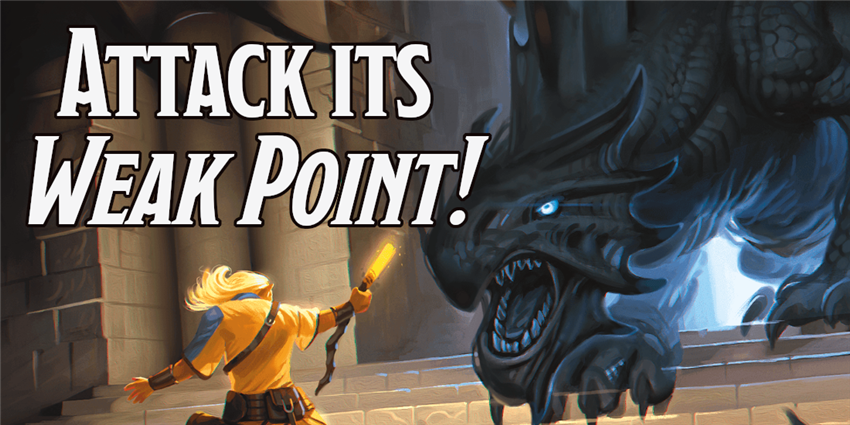
Attack Its Weak Point
The black dragon loomed above a fighter, a wizard, and a rogue, acid dripping from its scarred and twisted maw. “Death will come quickly… if you do not struggle,” it gleefully rasped. “Untevor the Sable has mercy upon compliant prey.”
The wizard desperately thought back to days in the academy long past, when she read the entirety of the Draconomicon from cover to cover in a weekend. “Untevor… the Sable… Oh!” She turned to the keen-eyed elven rogue that crouched beside her. “An old legend told by Skagri the Bard says that, in the Year of the Sundered Shield—”
“Get to the point!” the rogue hissed.
“Uh, Untevor the Sable has a scale tattooed with a rune of invulnerability! The source of his power! Can you find it?”
A line of acid exploded from the dragon’s mouth. The rogue moved almost before the blast left the beast's crackling maw, but the fighter and wizard only barely dodged in time. The fighter winced as a bright pink patch of burning flesh showed through his tunic, and tiny, sizzling pinholes sizzled all over their robes and armor. “Warrior!” shouted the rogue. “Get near the thing. Better to deal with its claws than its acid. I’ll look for the rune, and get your sword ready to carve the damn thing off!”
Some legendary monsters are nigh-invulnerable to attacks both physical and magical. However, despite being covered from head to foot in impenetrable scales, enchanted armor, or arcane tattoos, there is one tiny gap in their armor. A single weak point that their foes can exploit. This house rule was designed to only be applied to legendary monsters—that is, creatures that one or both of the following traits: Legendary Resistance or Legendary Actions. A full list of all legendary creatures can be found using the D&D Beyond Monsters tool. However, giving any monster 2 uses of the Legendary Resistance feature and two Legendary Action uses that it can use each turn (see Legendary Creatures in the Monster Manual) is enough to turn any monster that you want to use as a solo boss encounter into a legendary creature.
Invulnerablity
 A legendary creature that uses this weak point house rule will be called an invulnerable creature throughout this article. An invulnerable creature gains the following benefits:
A legendary creature that uses this weak point house rule will be called an invulnerable creature throughout this article. An invulnerable creature gains the following benefits:
- It is immune to bludgeoning, piercing, and slashing damage, in addition to its other damage immunities.
- It is resistant to all other forms of damage.
If the creature would gain immunity to a damage type it's already resistant to, the new immunity supersedes its resistance.
Weak Points
An invulnerable creature also has a weak point somewhere on its body that, if attacked, bypasses the creature’s damage resistances and immunities, and may even confer an additional drawback.
Finding the Weak Point. Identifying a creature’s weak point requires you to take the Search action to physically examine the monster. Make a Wisdom (Perception) or Intelligence (Investigation) check (DM’s choice) with a DC equal to 8 + the creature’s challenge rating. On a success, you identify the creature’s weak point. Once the weak point has been identified, you can tell your allies about it (no action required). Only a creature that knows the precise location of a creature’s weak point can attack it.
Legends of the Weak Point. Some invulnerable creatures are so infamous that legends are told of their greatness—and of their fatal weakness. If such a legend exists (at the DM’s discretion), you can use your action to make an Intelligence check with a DC equal to 8 + the creature’s challenge rating. Your DM may allow you to apply your proficiency in the Arcana, History, Nature, or Religion skill depending on the nature of the creature. On a success, you and any creatures that you tell of the legend have advantage on Wisdom (Perception) and Intelligence (Investigation) checks to identify the weak point.
Attacking the Weak Point. Once you’ve identified an invulnerable creature’s weak point, you can target it with a weapon or spell attack. The weak point has the same Armor Class as the invulnerable creature. In order to attack the weak point, you must take a –5 penalty to hit the small target. If the attack hits, it ignores the invulnerable creature’s damage resistances and immunities and deals an additional 10 damage. An attack against a monster’s weak point may also confer additional benefits, as described in “Variant Weak Points,” below.
However, some monsters’ weak points are obvious, like a beholder’s eye. If you can guess a creature’s weak point outright, and the DM determines that it’s trivial to spot the weak point, you can attack it without making a check to identify it. You still must take a –5 penalty to hit the small target. If your guess is correct, you gain the benefits of attacking the weak point (see “Attacking the Weak Point,” below). If your guess is incorrect, the attack is made against the invulnerable creature as normal.
Rules Tip: Attacks Only
Be aware that only attacks can affect a creature’s weak point. Effects that deal damage but don’t require an attack roll, such as spells or magical effects that require a saving throw, can’t specifically affect a creature’s weak point.
Self-Defense
Once a monster realizes its weak point is being targeted, it does its best to cover it. A beholder might partially close its central eye so that only a tiny slit remains for it to peer through, or a dragon might land and wrap one wing around the vulnerable soft patch in its chest. An invulnerable creature can use one of its legendary actions (or a bonus action on its turn) to cover the weak point until the start of its next turn.
Most creatures that cover their own weak point are able to grant that point three-quarters cover (note that this increases the AC of the weak point, making it even harder to hit). However, some creatures might be able to completely cover a weak point, or only cover a small portion of it, granting that point total cover or half cover at the DM’s discretion. If a weak point has total cover, the DM should include a way to remove that cover, such as by stunning or frightening the creature. Also at the DM's discretion, a creature covering its weak point might not be able to fight as effectively or take certain actions.
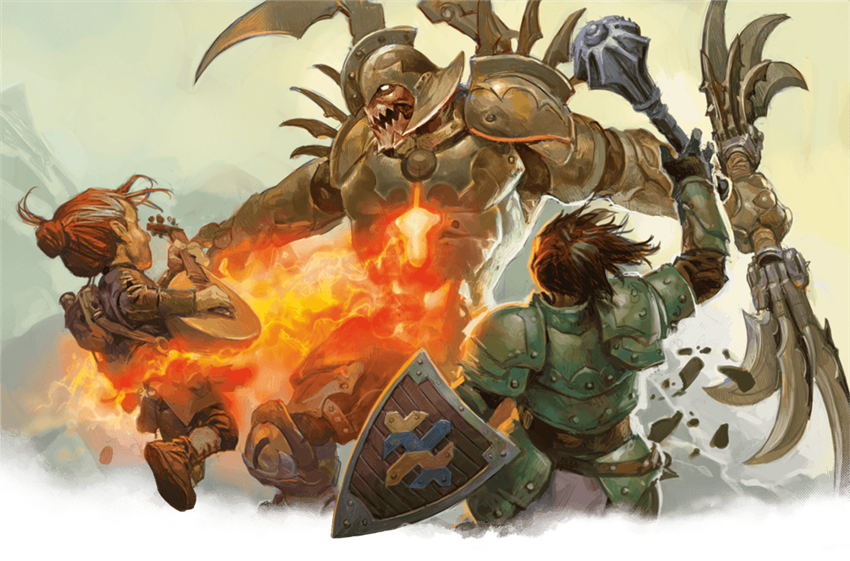
Variant Weak Points
The rules presented above are the core of this house rule. However, this system is designed to be incredibly flexible, allowing you to create monsters with many varied types of weak points to suit the story you want to tell. Consider using these variants on the rules presented above to keep your boss encounters from becoming rote.
Staggering Weak Point
This variant allows an attack against a creature’s weak point to bypass its damage immunities and resistances as normal, but doesn’t deal an additional 10 damage. Instead, the creature gains a condition that reduces its ability in combat. A beholder struck in its central eye might be blinded until the start of its next turn as a protective mucus forms. The best conditions for the DM to impose for striking a weak point are blinded, deafened, poisoned, and prone, since their effects are relatively minor.
The stunned condition can be applied, but only if it lasts until the start of the invulnerable creature’s turn. This lets the characters take advantage of the defensive penalties of the stunned condition, but without skipping the invulnerable creature’s next turn.
Weak Point Without Invulnerability
This variant changes the benefits of becoming an invulnerable creature. Instead of granting the creature the usual benefits of becoming invulnerable, maximize the creature’s hit points. For instance, an aboleth typically has 135 hit points, which is equal to the average of its hit dice (18d10) plus 36 (its Constitution modifier of +2 applied to each of its 18 hit dice). Instead of averaging its hit dice, maximize them for a result of 216 (180 + 36) hit points.
This alternative method makes it just as viable to damage the creature normally, but introduces a new location that makes it easier to defeat your foe. Perhaps this weak point is a runic sigil of vitality that was drawn by a shaman upon the creature’s skin, and the source of the magic is its weakest point.
Removable Invulnerability
This variant gives a weak point its own set of hit points. Once this weak point is destroyed, all of the benefits of invulnerability granted to the invulnerable creature are dispelled. In this case, the weak point should have hit points equal to about one-third of the monster’s hit point maximum. And as usual, the weak point isn’t subject to the damage resistances or immunities granted by being an invulnerable creature.
For example, an adult black dragon with a magical sigil of invincibility inscribed upon one of its innumerable scales is an invulnerable creature so long as the ensigiled scale is attached to its body. The dragon has 195 hit points, so cleaving the scale from the dragon’s body requires 65 points of damage be dealt to the weak point. Once it’s gone, its magic fades completely and the dragon can be damaged normally.
Recovering Invulnerability. As an additional variant, a monster could have a destructible weak point that recovers all of its hit points when certain conditions are met. A red dragon could inscribe a new rune of protection upon itself, thus restoring its weak point to full hit points, whenever it uses its Fire Breath. In this case, the weak point should have significantly fewer hit points; approximately one-sixth the invulnerable creature’s maximum hit points. To make the fight even more challenging, the weak point could appear on a different part of the creature's body whenever it is recovered.
Sequential Weak Points
This variant allows you to create creatures with multiple weak points. This variant works best with Gargantuan creatures, like ancient dragons or the legendary tarrasque, where their incredible size can make reaching any one specific weak point a challenge. A creature with three weak points may have only one be active at the beginning, and then have its other weak points activate sequentially as the creature takes damage—which in turn causes previous weak points to be destroyed or be sealed shut, granting them total cover. Divide the invulnerable creature’s hit points into a number of segments equal to the number of weak points it has, with one weak point being destroyed and a new one activating whenever one segment of the creature’s hit points is exhausted.
For example, a tarrasque with a weak point on its tail would require a party to attack it from behind until that weakness was exhausted and a new weak point activates between its shoulder blades. This new weak point would require the characters to get on the titan’s back in order to damage it. This gives your fight a sense of progression and requires you to react dynamically to the changing situation.
Multiple Active Weak Points. Alternatively, all of the creature’s weak points could be active at once. Once one of these weak points takes damage equal to one segment of the creature’s maximum hit points, it closes. For example, consider a tarrasque that has one weak point on all four of its legs that are open at once, and one on its head, which can only be damaged once all four of its legs are defeated. Each weak point can only take damage equal to 1/5 of the tarrasque’s maximum hit points before closing and becoming immune to damage. This requires you to choose between focusing fire or dividing your forces to conquer more of the creature at once.
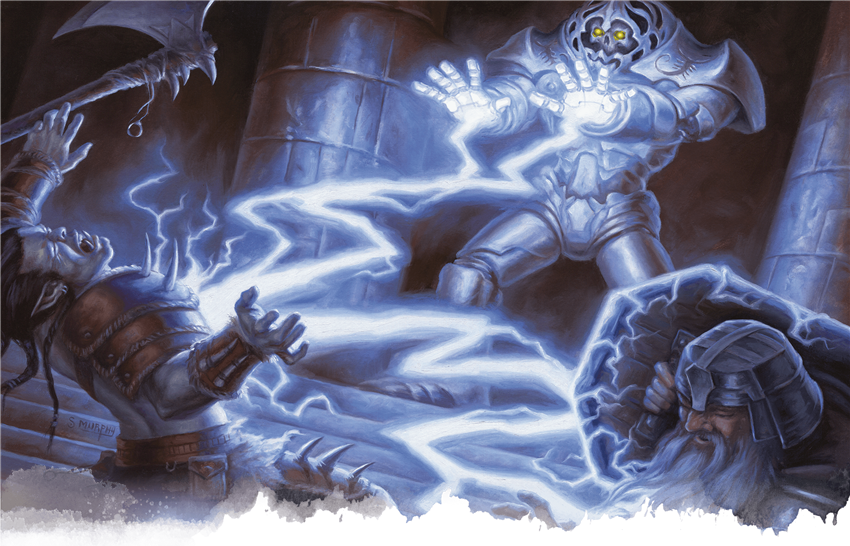
Challenges
With the house rule itself explained, let’s address challenges that you may encounter when implementing it, and how you can avoid them.
The “Called Shot” Problem
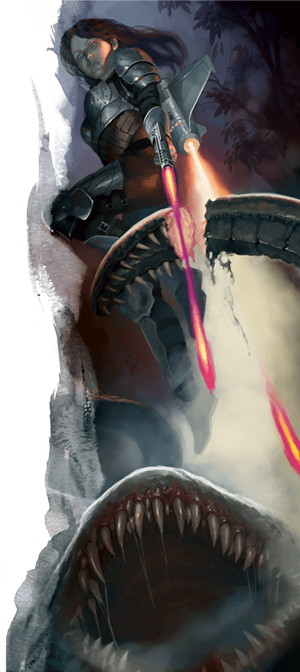 Many D&D players encounter problems when implementing a called shot mechanic—that is, a mechanic that allows them to target a specific part of a foe rather than just attacking the foe itself—because it breaks the standard assumptions of D&D.
Many D&D players encounter problems when implementing a called shot mechanic—that is, a mechanic that allows them to target a specific part of a foe rather than just attacking the foe itself—because it breaks the standard assumptions of D&D.
D&D’s combat is an abstraction. The concepts of attack bonuses, Armor Class, and hit points are particularly nebulous in order to make combat faster. Attack bonuses and Armor Class in particular always assume that the attacker is using the most powerful part of their weapon to attack the most vulnerable part of the defender. Likewise, it’s easy to think of hit points as the amount of literal sword cuts in their flesh a creature can take before keeling over dead. Called shot systems tend to break the realism of D&D’s abstract combat.
Imagine a character making a called shot at an ogre’s head, shooting an arrow clean through its skull, and then having the attack only deal a paltry amount of extra damage. Then imagine doing that three turns in a row, practically turning the creature’s skull into a sieve. How is that ogre still alive? Or, on the other hand, imagine a headshot actually working as an instant kill, allowing a 1st-level character to effectively deal 59 damage in a single shot to a full-health ogre.
This house rule suffers somewhat from the same problems as any subsystem that lets you target a specific point on a creature’s body. However, problems are mitigated by restricting how broadly it can be used: only certain monsters have specific weak points, and giving a monster a weak point also gives it increased defenses elsewhere. This puzzle-solving element specifically enhances boss encounters, rather than modifying every minor encounter in the game.
If you or your players are having trouble reconciling additional damage from called shots (the “headshot” problem, above), remember that hit points aren’t solely vitality. They’re an abstract representation of “physical and mental durability, the will to live, and luck.” Hitting a monster’s weak point may not have done much damage physically, but the power behind the blow could have winded the creature or left it shaken. On the other hand, a monster’s weak point might be much harder to pierce than a human’s skin! It’s easy to imagine a beholder’s eye or a lich’s exposed, necrotically-animated heart being as tough as a bulletproof vest. It’s a mythical monster, after all!
Determining Challenge Rating
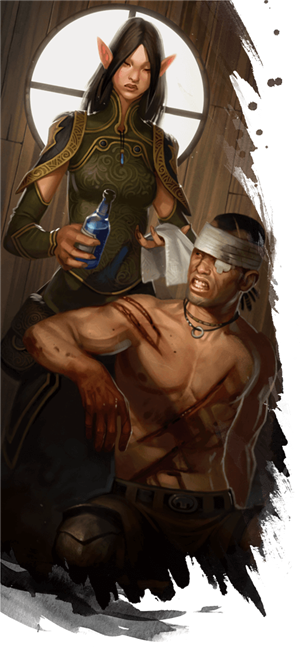 This subsystem has the chance to make an invulnerable creature much more challenging (or much easier, depending on how adept your characters are at identifying a creature’s weak point) than the legendary creature it was based on. As a rule of thumb, treat the invulnerable creature as the same challenge rating as the legendary creature it was based on; the advantages of its heightened defenses are generally canceled out by its new weaknesses.
This subsystem has the chance to make an invulnerable creature much more challenging (or much easier, depending on how adept your characters are at identifying a creature’s weak point) than the legendary creature it was based on. As a rule of thumb, treat the invulnerable creature as the same challenge rating as the legendary creature it was based on; the advantages of its heightened defenses are generally canceled out by its new weaknesses.
The first time you use this house rule, you may wish to treat the invulnerable creature’s CR as if it were 2 higher than the legendary creature it was based on. This is due to the fact that your players may waste some of their attacks flailing uselessly against the invulnerable creature’s hide before picking up on what’s going on. If you see this happening, you may not have provided enough information to your players—or you presented it too subtly.
A way to get around this might be to include minion creatures with very obvious weak points in the dungeon leading up to this creature; undead with exposed hearts, constructs with exposed wiring, or spiders with giant single eyeballs—all glowing targets for one-hit kills against these pathetic monsters. Now that your players have learned that monsters can have weak points, they might reach the conclusion that their greatest foes have hidden locations that can be specifically targeted to deal massive damage.
What Weak Points Can I Use?
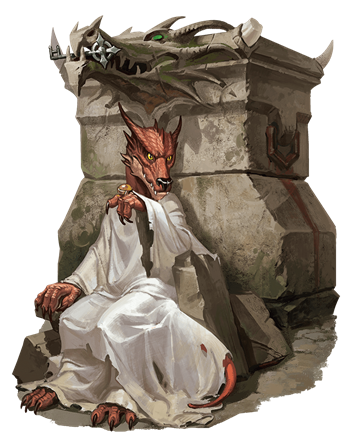 Not all legendary creatures have weak points as obvious as a beholder’s central eye. Most legendary creatures in D&D are actually humanoids with particularly powerful magic. When creating an invulnerable creature from a monster that doesn’t have any obvious anatomical weak points (other than, say, its head), what are some other options?
Not all legendary creatures have weak points as obvious as a beholder’s central eye. Most legendary creatures in D&D are actually humanoids with particularly powerful magic. When creating an invulnerable creature from a monster that doesn’t have any obvious anatomical weak points (other than, say, its head), what are some other options?
- A magically enlarged body part, such as an eye, hand, nose, or mouth, or a mechanical crab claw.
- A magical rune, about two inches in diameter, hidden somewhere on its body that powers a spell of invulnerability.
- Armor straps on a creature covered head to toe in armor; attacking these straps causes the armor to fall off in pieces.
- A spiritual core that maintains the creature’s physical form, like a heart of ice inside the water elemental princess Olhydra, or a talisman hidden in a mummy lord’s wrappings.
- An old wound carved in a demon lord’s chest by Zariel’s holy blade.
- A stone golem with a deep crack in its back hidden by a tapestry it wears like a cape.
- A warlock so closely bonded to their familiar that they share one another's life force; only wounding the familiar can wound the warlock.
- A magical ring of invulnerability worn upon the creature's finger, with amber light spilling from its enchanted gemstone.
What do you think of this house rule? Would you use it in your home game? What other variant weak points can you think of?
I mused about this topic on Twitter in December 2019. This article is based off of the stray thoughts I proposed and the feedback I received in that original Twitter thread.
Create A Brand-New Adventurer Acquire New Powers and Adventures Browse All Your D&D Content
 James Haeck is the lead writer for D&D Beyond, the co-author of Waterdeep: Dragon Heist, Baldur's Gate: Descent into Avernus, and the Critical Role Explorer's Guide to Wildemount, a member of the Guild Adepts, and a freelance writer for Wizards of the Coast, the D&D Adventurers League, and other RPG companies. He lives in Seattle, Washington with his fiancée Hannah and their animal companions Mei and Marzipan. You can find him wasting time on Twitter at @jamesjhaeck.
James Haeck is the lead writer for D&D Beyond, the co-author of Waterdeep: Dragon Heist, Baldur's Gate: Descent into Avernus, and the Critical Role Explorer's Guide to Wildemount, a member of the Guild Adepts, and a freelance writer for Wizards of the Coast, the D&D Adventurers League, and other RPG companies. He lives in Seattle, Washington with his fiancée Hannah and their animal companions Mei and Marzipan. You can find him wasting time on Twitter at @jamesjhaeck.








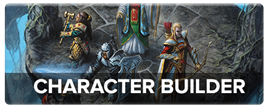
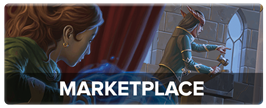
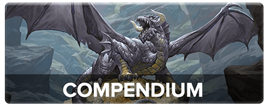
-
View User Profile
-
Send Message
Posted Jan 29, 2020Big fan of this concept. I'll have to play around with it but it has real promise.
-
View User Profile
-
Send Message
Posted Jan 29, 2020Good concept, especially if finding the weakness in unto itself, is an adventure fraught with danger.
-
View User Profile
-
Send Message
Posted Jan 29, 2020If this has some inspiration in video games: ATTACK THE GLOWING SPOT!!😁
I know of a one-shot where the Warlock said something to that effect regarding a Huge Mechanical Construct. (Turns out the weakness was the DM's dislike for the Rogue reciting the words to [Wickety] Wild, Wild West in entirety.)
-
View User Profile
-
Send Message
Posted Jan 29, 2020I love this idea as an epic house rule, although the Invulnerablity section confuses me a bit. The first bullet says that the creature gains immunity to bludgeoning, piercing and slashing damage in addition to its other immunities. The paragraph at the bottom of the section states that a creature with this that was already resistant to bludgeoning, piercing and slashing damage from non-magical effects becomes entirely immune to both magical and non-magical. Is that just clarifying that the immunity granted by the first bullet supersedes the base resistance or is it an additional effect caused by a normally resistant creature gaining Invulnerablity? If the creature's weak spot is destroyed, would they still be resistant to magical bludgeoning, piercing and slashing damage since they had that before becoming invulnerable or would that be gone as well?
-
View User Profile
-
Send Message
Posted Jan 29, 2020I love this idea of giving combat a bit of a story by making it more dynamic. My only worry is what to do if characters don't realize there is a weak point they need to find and deal with.
I particularly like the idea of introducing a villain or a minion that the party encounters that they cannot beat, and the idea of them finding out about this creature's weakness over the course of their adventure so they can encounter the villain once more, this time prepared to end things for good.
-
View User Profile
-
Send Message
Posted Jan 29, 2020This is one of the best house rules I've ever seen! Will likely use in my next campaign, and will suggest it to fellow DMs.
-
View User Profile
-
Send Message
Posted Jan 29, 2020Great concept!
My table ended up coming up with something similar on the fly; it ended being a big hit! Love how this article expands on what we were doing.
A new house rule I'm developing relates to calling shots / destroying limbs. Basically, some monsters can use limbs to get additional actions; like a wyvern who can use their tail-stinger in addition to their multiattack. The limb has its own AC and HP and, when the HP is reduced to 0, the limb is destroyed, the monster loses the associated action, and they take damage equal to the limb's max HP.
Hoping it spices up single-monster encounters!
-
View User Profile
-
Send Message
Posted Jan 29, 2020A freaking love this rule. For sure gonna be using it, especially since our new mythology based campaign already has a sorta video game vibe to it (though I'll be using it in many other campaigns too!).
FWI an easy way to get around the shot called rule is to just say, if the PC hits the creature, they just don't hit them exactly where they were intending. If you're aiming for the head the creature could turn at the last second so an arrow only grazes the side of their skull, or they raise their arm up in time for the arrow to hit that instead. Same thing goes if you're trying to stab someone in the heart. The creature could knock your strike off course so it doesn't pierce in as vital a location or as deeply :)
-
View User Profile
-
Send Message
Posted Jan 29, 2020From a roleplaying perspective, this has much to offer. It rewards players who take Proficiencies typically overlooked by the min/max combat beasts.
It also creates opportunities for social role play. "conducting some local investigation to uncover a clue to an old sage who tells of a book that holds a secret" kind of stuff.
Ultimately it rewards smart play with a sense of accomplishment. It still allows for the "headstrong charge in and whack em until they stop" players but inspires those players who prefer to go in with all the aces in their sleeves.
-
View User Profile
-
Send Message
Posted Jan 29, 2020This rule is terrible for so many reasons because it heavily limits what kind of creatures you can throw at your group. For instance if the weak point is on it's back and you have to climb on it WELL there are many types of groups that dont have good strength scores and no one will be trained in athletics, so they dont have a element needed to kill it, or on the other hand it will let your players steam roll everything, more so if you have tool box characters like druids or bards in your group. Ok the weak point is on its head? Conjure animals, something flying now peck the shit out of its head after I hit it with fairy fire or entangle roots
-
View User Profile
-
Send Message
Posted Jan 29, 2020The paragraph beneath the bullet points is solely for clarification. But it seems like it's more confusing than it is clarifying!
Said a different way, an invulnerable creature becomes immune to bludgeoning, piercing, and slashing damage from both nonmagical and magical attacks, regardless of whatever damage resistances it had before.
-
View User Profile
-
Send Message
Posted Jan 29, 2020Just a note about some of the links in the article - they seem to use the link formatting and link to the Monster Manual and Player's Handbook compendiums, when those same rules appear in the basic rules. If you used the tooltip syntax instead, those links would not only have tooltips, but also be accessible to those who don't own the MM or PHB on D&D Beyond.
A list of the sections/links I'm talking about:
I don't think there's a tooltip pointing to this one, but it's here in the basic rules: https://www.dndbeyond.com/sources/basic-rules/monsters#LegendaryCreatures
There's a tooltip for this, using "action": the Search action.
Each kind of cover can be referenced with the "rule" tooltip: three-quarters cover, half cover, and total cover.
There's also a single typo here:
(Each skill named in the article could also be tooltipped if you wanted, but that's not really an issue, as people can also just look those up themselves if they want.)
Anyway, this is a really interesting concept. I imagine it kind of goes against 5e's design philosophy of both simplicity and of generally avoiding making it so there's only one "right way" to approach an encounter... Though I suppose it doesn't really restrict it too much, in that you're not being prevented from attacking it in the way you want, but it does discourage using things that aren't attacks. I do appreciate you acknowledging the potential pitfalls of this method and addressing how to deal with them in the article itself :)
-
View User Profile
-
Send Message
Posted Jan 29, 2020I'm curious why the monster being more difficult to defeat makes it hard to find lore about it's weak points. Is this because lower CR creatures are more commonly known even if not as legendary or merely for mechanical convenience or am I overlooking something? Thanks! I really like this rule and I don't normally like home brew. I may use this once or twice just to spice things up.
-
View User Profile
-
Send Message
Posted Jan 29, 2020I see your reference and I raise you one giant crab
-
View User Profile
-
Send Message
Posted Jan 30, 2020It's a purely mechanical device. If you think that a creature would have a particularly well-known legend (specifically regarding an ancient wound it received, or regarding the source of its power, etc., etc.) then lowering the DC or giving advantage on the check would be completely appropriate.
-
View User Profile
-
Send Message
Posted Jan 30, 2020The point is those are all options, so here is a method to employ it. Know your group before doing something like this, and adjust accordingly. Use the variant rules to avoid the conjure animals issue, etc.
-
View User Profile
-
Send Message
Posted Jan 30, 2020It feels a bit weird to me that the higher the challenge rating is, the higher the difficulty is to recall legends about the weak point. In most cases, it seems as though higher CR monsters are more famous/infamous and so word of their weakness would be more widely spread. Also, the ease with which you can find the weak spot seems to depend more on the weak spot itself than the CR of the monster.
-
View User Profile
-
Send Message
Posted Jan 30, 2020Was Achilles weak in his heal in the Illiad, or was that something that Virgil made up for the Aeneid?
-
View User Profile
-
Send Message
Posted Jan 30, 2020It was something that was added later. The Iliad itself didn't describe Achilles's death.
-
View User Profile
-
Send Message
Posted Jan 30, 2020I like the idea of it. I will have to bring this up and see what my group thinks.
I think maxing hit points and giving resistance to every thing except the weakness is great for low level bosses while high level ones might have involunablity. Low level creatures might not have access to the involunablity but will be very tough instead.
Thank you for the idea